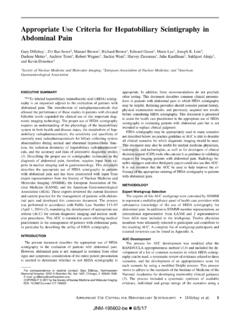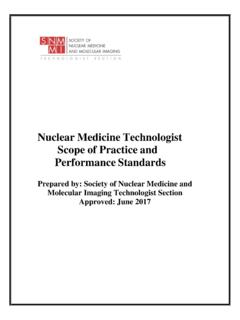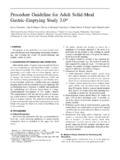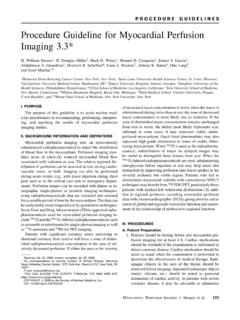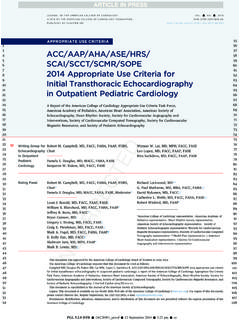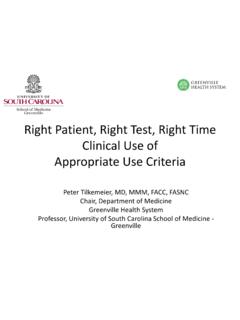Transcription of Appropriate Use Criteria for Ventilation–Perfusion Imaging ...
1 Appropriate Use Criteria for ventilation PerfusionImaging in pulmonary EmbolismAlan D. Waxman1, Marika Bajc2, Michael Brown3, Frederic H. Fahey1, Leonard M. Freeman1, Linda B. Haramati4,Peter Julien4,Gr goire Le Gal5, Brian Neilly2, Joseph Rabin6, Gabriel Soudry1, Victor Tapson7, Sam Torbati3,Julie Kauffman1, Sukhjeet Ahuja1, and Kevin Donohoe11 Society of Nuclear Medicine and Molecular Imaging ;2 European Association of Nuclear Medicine;3 American College of EmergencyPhysicians;4 American College of Radiology;5 American Society of Hematology;6 Society of Thoracic Surgeons; and7 AmericanCollege of Chest PhysiciansEXECUTIVE SUMMARYP erfusion lung Imaging for diagnosing pulmonary embolism (PE)was introduced 50 y ago (1). At that time, it offered a noninvasivealternative to pulmonary angiography in patients with a clinical sus-picion of PE.
2 Because there are many causes of diminished regionalblood flow in the lungs, particularly redistribution of blood flow awayfrom regions with lung disease, the subsequent introduction of radio-nuclide ventilation studies added greater specificity to findingson radionuclide perfusion Imaging . When appropriately usedand interpreted, ventilation perfusion (V/Q) scintigraphy is an im-portant examination for the evaluation of patients suspected of hav-ing regional compromise of lung perfusion and purpose of this document is to describe the Appropriate useof V/Q scintigraphy in patients suspected of having acute PE. Itis hoped that through these recommendations, V/Q scintigraphywill be appropriately applied to benefit from the Society of Nuclear Medicine andMolecular Imaging (SNMMI), the European Association of NuclearMedicine (EANM), the American Society of Hematology (ASH),the Society of Thoracic Surgeons (STS), and the American Collegeof Emergency Physicians (ACEP), as well as chest radiologists,emergency department physicians, pulmonary critical care physi-cians, and physician experts in thromboembolic disease, assembledas an autonomous workgroup to develop the following appropriateuse Criteria (AUC).
3 This process was performed in accordance withthe Protecting Access to Medicare Act of 2014 (2). This legislationrequires that all referring physicians consult AUC using a clinicaldecision support mechanism beforeordering any advanced diagnosticimaging service. Such services are defined as diagnostic MRI, CT,nuclear medicine procedures (including PET), and others as specifiedby the secretary of Health and Human Services in consultation withphysician specialty organizations and other stakeholders (2). TheseAUC are intended to aid referring medical practitioners in the appro-priate use of V/Q scans in patients suspected of having PE (3).INTRODUCTIONThe following document describes the Appropriate use of V/Qscans in patients suspected of having PE. The authors have tried tocover the most common clinical scenarios for this use.
4 However,the reader is reminded that a patient may present with variationsof the scenarios covered here, or with signs or symptoms notdescribed, for which V/Q scanning may still be indicated. Thisdocument is presented to assist health-care practitioners consid-ering V/Q scanning in patients suspected of having PE; however,each patient is unique, as is each patient s clinical presentation,and therefore this document cannot replace clinical scanning can also be used for other conditions. These otherscenarios are beyond the scope of this the past half century, V/Q lung scintigraphy has beena sensitive and useful tool to detect the presence of PE. CTpulmonary angiography (CTPA) was introduced in the mid-1990s,and subsequently this technology demonstrated the ability todetect peripheral or subsegmental PE (4).
5 CT scans are morecommonly available 24 h a day, 7 d per week, as compared withnuclear medicine studies. In addition, CTPA diagnostic algorithmsare simpler and able to depict pulmonary , pleural, mediastinal, andchest wall lesions that may cause symptoms similar to those of these attributes, CTPA has become the most common pro-cedure for the diagnosis of PE. On the other hand, CTPA may becontraindicated in some patients, such as those with intravenousradiographic contrast reactions or renal failure. Therefore, in manypatients, V/Q scintigraphy may be warranted as the primary im-aging procedure when PE is exquisite anatomic detail of CTPA has raised concernsabout the overdiagnosis and overtreatment of small, clinicallyinsignificant PEs and the frequent reporting of new incidentalfindings that require further work-up (5,6).
6 A third and evengreater concern is the patient s CTPA radiation exposure, partic-ularly to the radiosensitive breast tissue of young protect the systemic circulation, the pulmonary arteries andcapillary beds uniquely possess properties that both trap and lysesmall subsegmental clots, suggesting that small PEs are commonphysiologic phenomena (3,7). It is not, however, uncommon forradiologists viewing an abdominal CT examination to see incidentalPEs at the lung bases. Physiciansin the United States tend to treatthese small PEs, although the wisdom for treating small, incidentallydiscovered PEs has been questioned. A recent policy statement fromthe American College of Chest Physicians (ACCP) (8)saysthatforsubsegmental PEs and no proximal deep vein thrombosis (DVT),clinical surveillance is suggested over anticoagulation when there isa low risk of recurrent venous PE (venous thromboembolism [VTE])and anticoagulation is suggested over clinical surveillance when thereFor correspondence or reprints contact: Alan Waxman, Cedars-SinaiMedical Center, 8700 Beverly Blvd.
7 , Room A042, Los Angeles, CA : 2017 by the Society of Nuclear Medicine and Molecular FORVENTILATION PERFUSIONIMAGING INPULMONARYEMBOLISM1is a high risk of recurrent venous PE. As stated by Goodman (3), theonly 3 reasons to treat small PEs are inadequate cardiopulmonaryreserve, coexisting acute DVT, and prevention of chronic PEs andpulmonary artery hypertension in patients with an increasing clinical consensus that not all PEs should betreated, it is clear that PE Imaging is best evaluated on the basis ofoutcomes rather than accuracy. In a prospective study comparingV/Q and CTPA, Anderson et al. (9) showed that the outcomes(based on a 3-mo follow-up of negative cases) were similar(false-negative rate,#1%) despite the fact that more PEs weredetected with CTPA than with V/Q scans ( for CTPA for V/Q).
8 Similar outcome data have also been described ina large retrospective analysis (10).Many of the referrals for patients with suspected PE are for thepresence of shortness of breath or hypoxemia. Both V/Q scansand CTPA can assist in diagnosing the cause of hypoxemia orshortness of breath. This document is therefore written to assist allmedical practitioners in the Appropriate use of V/Q scintigraphy inall patients that present with signs or symptoms of two basic methods used to perform V/Q studies are planarimaging and SPECT. SPECT combined with low-dose CT has gainedsome popularity as well. Both methods have excellent performancecharacteristics in the diagnosis ofclinically significant PE. SPECT,similar to CTPA, may demonstrate the presence of small, subsegmentalemboli, which, if uncomplicated, maynot require treatment.
9 There isregional variation in the choice of V/Q methodology, with V/Q planarimaging being the preferred study in the United States (11) whereasV/Q SPECT is favored by the EANM and preferred in Europe,Australia, and some countries in Asia (11,12).V/Q Planar ImagingThe standard planar examination consists of 8 ventilation viewsand 8 perfusion views (anterior, posterior, both lateral, both anterioroblique, and both posterior oblique) obtained in the same ventilation study generally precedes the perfusion different radiopharmaceuticals have been used for gas was commonly used in the past; however, in manycenters xenon has been supplanted by aerosols. Presently, the mostcommonly used aerosol is99mTc-diethylenetriaminepentaacetic and99mTc-sulfur colloid aerosols are also in usewith similar success.
10 Some centers are using krypton gas. Severaldifferent kits are commercially available to administer these promising new agent not yet approved for use in the United States isan Australian product, Technegas (Cyclomedica), which produces afine carbonized particle suspensionwith deep alveolar penetration (13).The perfusion study is performed with99mTc-macroaggregatedalbumin. These albumin particles average 20 70mm in size,which effectively allows them to lodge in the pulmonary capillar-ies and distal arteriolar tree. A typical 111- to 185-MBq (3 5 mCi)dose will contain 200,0002700,000 particles, which will embolizeless than 1% of the pulmonary capillary bed (14). The packageinsert from the manufacturer (Jubilant DraxImage) cautions againstuse in patients with severe pulmonary arterial hypertension; alter-natively, some investigators choose to reduce the number of ad-ministered particles in these patients (15).
